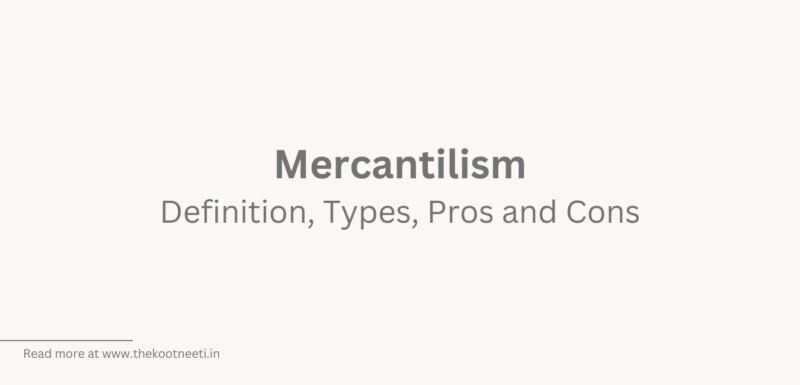Mercantilism: Definition, Types, Pros and Cons

Mercantilism is an economic theory and system that emerged in Europe during the early modern period (16th-18th centuries). It is based on the idea that a country’s wealth and power depend on its ability to accumulate gold and silver, and on its trade with other countries.
According to mercantilist theory, a country should promote exports, discourage imports, and accumulate precious metals through a favorable balance of trade. Mercantilist policies often included measures such as tariffs and other trade barriers to protect domestic industries and to encourage exports, as well as colonial expansion to secure access to resources and markets.
Mercantilism was the dominant economic theory and practice in Europe during the early modern period, but it fell out of favor in the 19th and 20th centuries due to the rise of liberal economic theory and the increased importance of manufacturing and industrialization. Despite its decline, elements of mercantilism continue to influence international trade and economic policy in some countries.
Types of mercantilism
There are several types of mercantilism, including:
- Export-led mercantilism: This type of mercantilism emphasizes the promotion of exports and the accumulation of gold and silver through a favorable balance of trade. It typically involves the use of tariffs and other trade barriers to protect domestic industries and to encourage exports.
- State-led mercantilism: This type of mercantilism involves the active intervention of the state in the economy, including through the regulation of trade, the promotion of certain industries, and the protection of domestic producers.
- Colonial mercantilism: This type of mercantilism involves the expansion of a country’s colonies and the exploitation of their resources and labor in order to benefit the mother country.
- Industrial mercantilism: This type of mercantilism involves the promotion of domestic manufacturing and the protection of domestic industries through the use of tariffs and other trade barriers.
- Financial mercantilism: This type of mercantilism involves the manipulation of financial policies, such as the control of interest rates and the manipulation of exchange rates, in order to promote exports and accumulate gold and silver.
Here are some pros and cons of mercantilism:
Pros:
- Mercantilism can help to increase a country’s wealth by encouraging exports and discouraging imports.
- It can help to stimulate domestic industries and create jobs by protecting them from foreign competition.
- It can help to promote self-sufficiency and reduce a country’s reliance on foreign sources of goods.
Cons:
- Mercantilism can lead to protectionist policies, such as tariffs and quotas, which can raise the cost of goods for consumers and lead to trade conflicts with other countries.
- It can discourage innovation and efficiency by protecting domestic industries from competition.
- It can lead to a focus on short-term gains rather than long-term economic growth and development.
- It can create economic imbalances and distort the international trade system.
Difference with Capitalism
Mercantilism and capitalism are two economic systems that have shaped the modern world. While they have some similarities, they also have a number of important differences.
Mercantilism is an economic system that is based on the idea that a country’s wealth and power were determined by its supply of gold and silver. Mercantilist policies sought to increase a country’s wealth by encouraging exports and limiting imports, in order to build up a surplus of gold and silver. Mercantilist economies were characterized by state intervention in the economy and the promotion of manufacturing and trade.
Capitalism is an economic system that is based on the private ownership of the means of production and the creation of goods and services for profit. In a capitalist economy, prices are determined by supply and demand, and the production and distribution of goods and services are guided by the profit motive. Capitalism is characterized by a high degree of economic freedom and competition, and it relies on a market system to coordinate economic activity.
There are several key differences between mercantilism and capitalism. Mercantilism is based on the idea of a zero-sum game, in which one country’s gain is another country’s loss, while capitalism is based on the idea of mutual benefit and the belief that trade can create wealth for all parties involved. Mercantilist economies are characterized by state intervention and protectionism, while capitalist economies are characterized by free markets and free trade. Finally, mercantilism is focused on the accumulation of gold and silver, while capitalism is focused on the creation of wealth through the production and exchange of goods and services.



















